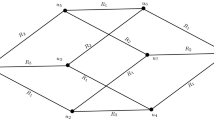Abstract
Graph theory has found many application area in science, engineering, and mathematics. In order to expand the application base, the notion of a graph was generalized to that of a hypergraph, that is, a set X of vertices together with a collection of subsets of X. In this chapter, we fuzzify the notion of a hypergraph and state some possible applications. The results are taken from [9,10,11,12,22].
Access this chapter
Tax calculation will be finalised at checkout
Purchases are for personal use only
Preview
Unable to display preview. Download preview PDF.
Similar content being viewed by others
References
Berge, C., Graphes et Hypergraphes, Dunod, Paris, 1972.
Berge, C., Hypergraphs, North Holland, Amsterdam, 1989.
Bezdek, J. C., Partition structure: a tutorial, in Analysis of Fuzzy Information, vol. III, CRC press: Boca Raton, pp. 81–108, 1987.
Bollobas, B., Graph Theory on Introductory Course, Springer -Verlag: New York, 1979.
Bouchon, B. and Cohen, G., On fuzzy relations and partitions, in Advances in Fuzzy Sets, Possibility Theory and its Applications, P. P. Wang (ed.), pp. 97–105, 1983.
Constantin-Paton, M. and Prusky, G., The basis of “recognition” at the synaptic level, in: Price, D.L., Thoenen, H. and Aguayo, A.J., Eds., Neurodegenerative Disorders, Mechanisms and Prospects for Therapy ( Wiley, Chichester, 1991 ) 127–144.
Das, M., A note on fuzzy hypergraphs and their duals, unpublished (1987).
Dubois, D., and Prade, H., Fuzzy Sets and Systems: Theory and Applications, New York: Academic Press 1980.
Goetschel, R., Jr., Introduction of fuzzy hypergraphs and Hebbian structures, Fuzzy Sets and Systems 76: 113–130, 1995.
Goetschel, R., Jr., Craine, W., Voxman, W., Fuzzy transversals of fuzzy hypergraphs, Fuzzy Sets and Systems 84: 235–254, 1996.
R. Goetschel, Jr., Fuzzy colorings of fuzzy hypergraphs, Fuzzy Sets and Systems, 94: 185–204, 1998.
Goetschel,R. N., Jr., and Voxman, W., Intersecting fuzzy hypergraphs, Fuzzy Sets and Systems, 99: 81–96, 1998.
Graver, J. E., and Watkins, M. E., Combinatorics With Emphasis on Theory of Graphs, Springer-Verlag, Berlin, 1977.
Hebb, D.O., The Organization of Behavior ( Wiley, New York, 1949 ).
Ismail, M. A., Soft clustering: algorithm and validity of solutions, in Fuzzy Computing, Gupta, M. M., and Yamakawa, T.,(ed.), Elservier Science, North Holland, pp. 445–471, 1988.
Kaufmann, A., Introduction à la Thèorie des Sous-Ensemble Flous, vol. 1, Masson: Paris 1977.
Kaufmann, A., Introduction à la Thèorie des Sous-Ensemble Flous, vol. 4, Masson: Paris 1977.
Kuroki, N. and Mordeson, J. N., Successor and source functions, J. Fuzzy Math., 5: 173–182, 1997.
Kuroki N. and Mordeson, J. N., Structure of rough sets and rough groups, J. Fuzzy Math., 5: 183–191, 1997.
Lee-Kwang, H., and Favrel, J., Hierarchical reduction and decomposition method of Petri nets, IEEE Trans.Syst.Man.Cybern., vol. SMC-15, pp. 272–280, 1985.
Lee-Kwang, H., and Favrel, J. and Oh, G., Hierarchical decomposition of Petri net languages, IEEE Trans. Syst. Man. Cybern., vol. SMC-17, pp. 877–878, 1987.
Lee-Kwang, H., and Lee, K.-M., Fuzzy Hypergraph and Fuzzy Partition, IEEE Trans. Syst., Man,.and Cybern., vol. SMC -25, pp. 196201, 1995.
Lorente de Nó, R., Synaptic stimulation of motoneurons as a local process, J. Neurophysiol. 1: 195–206, 1938.
Lynch, G., Synapses, Circuits, and the Beginnings of Memory, MIT Press, Cambridge, MA, 1986.
Mordeson, J. N., Rough set theory applied to (fuzzy) ideal theory,Fuzzy Sets and Systems, to appear.
Mordeson, J. N., Algebraic properties of spaces in rough fuzzy set theory, NAFIPS’99, 56–59, 1999.
Morsi, N. N. and Yakout, M. N., Axiomatics for fuzzy rough sets, Fuzzy Sets and Systems, 100: 327–342, 1998.
Orlawska, E., Semantic analysis of inductive reasoning, Theoretical Computer Science, 43: 81–89, 1986.
Papadimitrion, C. H.and Steiglitz, K., Combinatorial Optimization: Algorithms and Complexity, Prentice Hall: Englewood Cliffs, 1982.
Pawlak, Z., Rough sets, Int. J. Comp. Sci., 11: 312–356, 1982.
Pawlak, Z., Rough Sets, Theoretical Aspects About Data, Kluwer Acad. Pub., 1991.
Pedrycz, W. and Hirota, K., An application of probabilistic sets to fuzzy clustering, in Analysis to Fuzzy Information, vol. III, CRC Press: Boca Raton, pp. 170–181, 1987.
Pomykala, J. A., Approximation operations in approximate space, Bulletin of the Polish Academy of Sciences: Mathematics, 35: 653–662, 1987.
Wasilewska, A., Conditional knowledge representation systems–model for an implementation, Bulletin of the Polish Academy of Sciences: Mathematics, 37: 63–69, 1987.
Wasilewska, A. and Vigeron, L., On generalized rough sets, preprint.
Wybraniec - Skardowska, U., On a generalization of approximation space, Bulletin of the Polish Academy of Sciences: Mathematics, 37:51-61, 1989.
Yao, Y. Y., Relational interpretations of neighborhood operators and rough set approximation operators, preprint.
Yao, Y. Y., Two views of the theory of rough sets in finite universes, Int. J. Approximate Reasoning, 15: 291–317, 1996.
Yao, Y. Y. and Lin, T. Y., Generalization of rough sets using modal logics, Intelligent Automation and Soft Computing, 2:103-120, 1996.
Zakowski, W., Approximations in the space (U, II), Demonstratio Mathematica, XVI: 761–769, 1983.
Zimmermann, H.-J., Fuzzy Set Theory and its Applications, Nijhoff Publishing, Dordrecht, 1985.
Author information
Authors and Affiliations
Editor information
Editors and Affiliations
Rights and permissions
Copyright information
© 2000 Springer-Verlag Berlin Heidelberg
About this chapter
Cite this chapter
Mordeson, J.N., Nair, P.S. (2000). Fuzzy Hypergraphs. In: Mordeson, J.N., Nair, P.S. (eds) Fuzzy Graphs and Fuzzy Hypergraphs. Studies in Fuzziness and Soft Computing, vol 46. Physica, Heidelberg. https://doi.org/10.1007/978-3-7908-1854-3_4
Download citation
DOI: https://doi.org/10.1007/978-3-7908-1854-3_4
Publisher Name: Physica, Heidelberg
Print ISBN: 978-3-7908-2471-1
Online ISBN: 978-3-7908-1854-3
eBook Packages: Springer Book Archive




